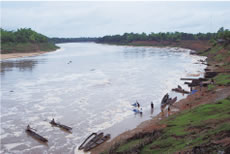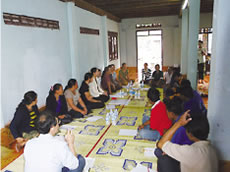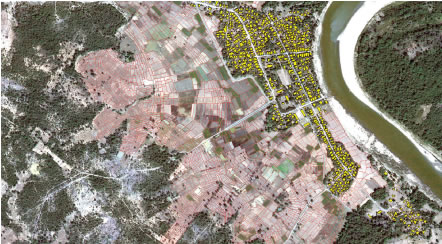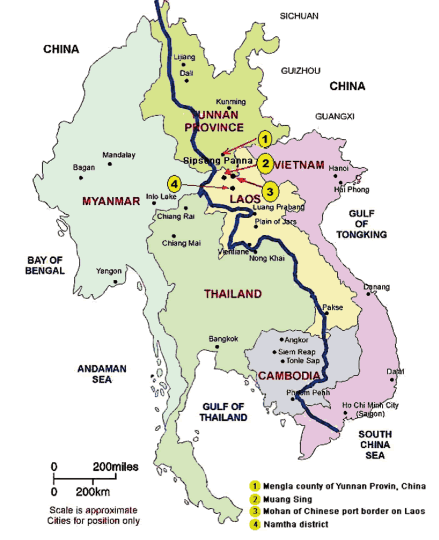RIHN EcoHealth Project |
Our Project
This project examines the relationships between recent changes in climate and
environment and those in the health profile of the people of tropical monsoon
Asia. The project examines the effects of human societal and environmental
changes on the ecology, endemiology/epidemiology of several vector-borne
diseases, such as malaria, dengue fever, and filariasis, and food- and
water-borne diseases, such as liver fluke infection, cholera and other diarrheal
diseases.
Background
The health profile of a human population can be seen as a product of the human ecosystem—an ecosystem comprised of both biophysical and human elements. The construction and conservation of sound human ecosystems, therefore, is essential to the health and survival of human populations. The field of ecohealth considers human health and disease in relation to environmental conditions; it can improve attempts to address disease and local and global environmental problems.
Tropical monsoonal Asia is characterized by distinct wet and
dry seasons. The region is susceptible to flood and drought. Rice is the
traditional staple food of this area and is cultivated by either slash-and-burn
methods or in wet paddies. People chop down the tropical forest and cut terraces
in which to cultivate rice, but they also remain dependent on a variety of
forest products. Recently, population increase and migration, economic
development, urbanization, deforestation and lifestyle changes have dramatically
affected the ecological conditions of region, and so the relations between human
beings, pathogens and vectors.
Research Methods and Target Organization
The project consists of three study groups, each containing several sub-groups, as follows:
1) The Field Study Group consists of research teams in Lao PDR, Bangladesh, China, and a Southeast Asia comparative study team.
2) The Methodology Study Group consists of historical, agro-forestry, human ecology and health education study teams.
3) The Integration Team manages the project by supporting activities of the field study group and the methodology group and by integrating the results of the project.
The project concluded MOUs in 2008-2009 with the National
Institute of Public Health, Ministry of Health (NIOPH), Lao PDR, and the
International Centre for Diarrhoeal Disease Research, Bangladesh (ICDDR,B). The
project established the "Lao-Japan Consortium on Health Research" to facilitate
systematic and comprehensive health research in Lao. It co-organized the Second
National Health Research Forum in September 2008, and invited the Health
Minister of Lao PDR to the RIHN Special Meeting on gEcohealth Promotionh in
November, 2008.
 Photo 1
Photo 1
The Banghiyang River, Lahanam area, Songkhone district,
Savannakhet Province of Lao PDR, one of tributaries of the Mekong river. This
area is frequently damaged by flood. At the same time, however, it has reaped
the benefit of the river for wet rice cultivation and fisheries. Fishing
activities in the river and flood plain are very active, as is the river fluke
parasite Opisthorchis viverrini.
 Photo 2
Photo 2
Meeting of local staff of the Lahanam Demographic Surveillance
System (DSS). All the houses of the area are regularly visited by the staff,
which collects information on pregnancy and birth, death, marriage and
migration. These data form one base of the study of the health transitions
underway in this area.
Results to date
1) The Lao study team conducted demographic and health research in Lahanam area, Savannakhet Province, focusing on maternal and child health. The team also initiated surveys on the health system, school health, and incidence of malaria among indigenous groups residing in remote areas of the Sepone district.
2) In Bangladesh, studies of relation between climate and infectious disease in Matlab were initiated in collaboration with ICDDR,B, Nagasaki University, Kyoto University, Tsukuba University, and the London School of Hygiene and Tropical Medicine. An automated weather observation system (AWS) was installed in Matlab to collect climate data. We have also been working in collaboration with the Institute of Epidemiology, Disease Control and Research, Bangladesh, and Cambridge University to establish a national disease database.
3) The China study team carried out survey on HIV/AIDS in cooperation with Kunming Medical College and the Yunnan Health and Development Research Association (a NPO), focusing on social change and population mobility. The team is to develop a research network of HIV/AIDS in the Greater Mekong Region.
4) The historical study team collected and analyzed historical data on infectious diseases in East and Southeast Asia, held an international workshop in Taiwan, and has analyzed medical information in the British Parliamentary Papers (BPP).
5) The agro-forestry study team focused on changes in land-use and land-cover in Southeast Asia, using satellite images to establish GIS-based data on environmental change.
6) The human ecology study team made community-level assessments of the current state and change in local environment, life style, and health.
7) The health education study team developed an ecohealth questionnaire to be administered in communities and schools to collect information on environmental changes and lifestyle changes.
r @q @` @@QOOX@@
Lao PDR
1) Analysis of land-cover changes;
2) Study of child health
and nutrition in LahanamG
3) Demographic study in Lahanam;
4) Water
quality study, mainly in Sepone, SVKG
5) Thai liver fluke study in Lahanam
(including fish survey);
6) Malaria study using mobile phone in Sepone,
SVK;
7) Health system strengthening using mobile phone network;
8)
Promotion and education of ecohealth concept through folk-media;
9)
Community-oriented development of ecohealth (CODE) in community and
school;
10) Historical study of health transition (through database
construction);
11) Comparative village study on human ecological
transition;
12) Results of National Health Survey 2000 and environment.
Bangladesh and Sri Lanka
1) Study of relation between climate and diseases;
2)
Constructing reporting system of the national disease surveillance system;
3)
Lota-virus infection in Sri Lanka;
4) Analysis of land-cover changes in
Bangladesh.
China
1) Study on HIV transmission and the behavior of female
commercial sex workers and their clients;
2) Collection of historical data on
schistosomiasis control in southern China. epidemiology.
photo 3
 Satellite image of Lahanam area. Houses, rice fields and forest are identified.
Analyses of the ALOS satellite image of all area of Lao and Bangladesh will be
executed in the
project
Satellite image of Lahanam area. Houses, rice fields and forest are identified.
Analyses of the ALOS satellite image of all area of Lao and Bangladesh will be
executed in the
project
Figure 1

The economic and social influences of China in this area are remarkable. The
project has studied the epidemiology of HIV/AIDS in the region, especially among
highly mobile populations in the South China border zone.